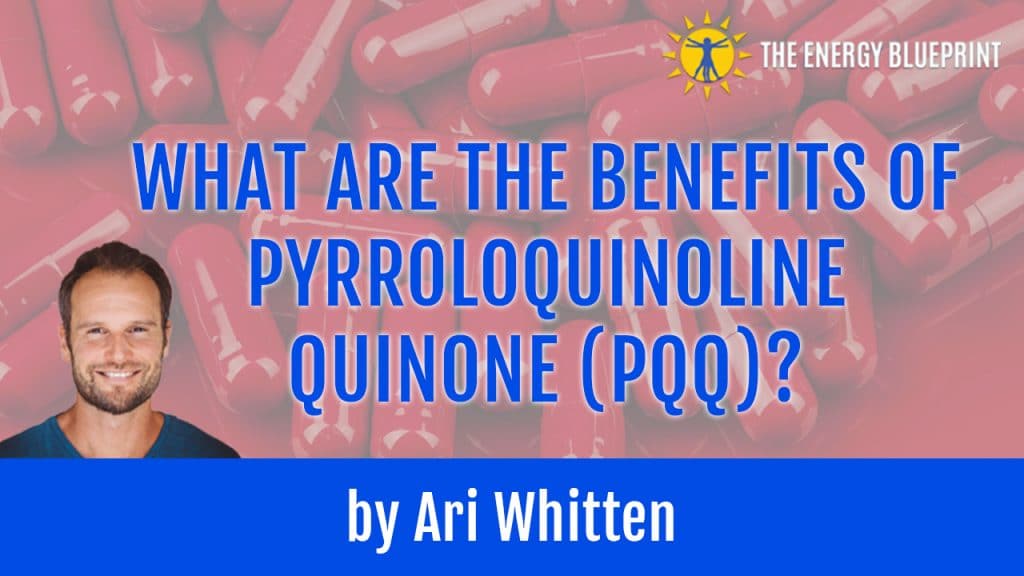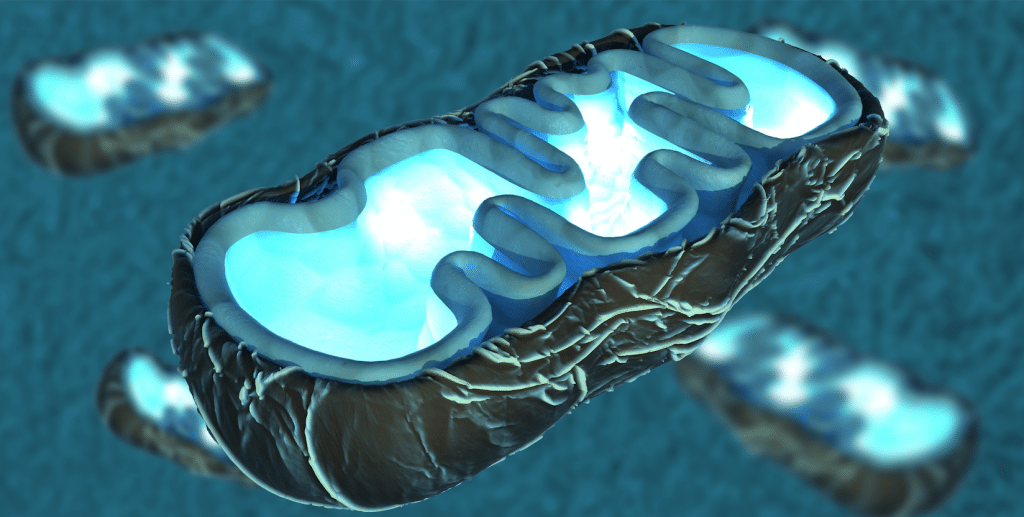
show
What are Mitochondria?
Mitochondria are the energy factories or powerhouses of the cell. They are organelles that take in nutrients, break them down, and create energy for the cell in a process known as cellular respiration. Each cell in the human body has hundreds to several thousand mitochondria, and they use over 90% of the oxygen we breathe. By weight, they make up about 10% of the human body.
Energy production, which is the primary function of mitochondria, is the foundation for health and well-being. It is critical for movement as well as consciousness. Even subtle deficits can cause weakness, fatigue, and cognitive impairment. Mitochondrial dysfunction has been implicated in a host of degenerative diseases, such as heart disease, type 2 diabetes, Alzheimer’s disease, Parkinson’s disease, depression, fibromyalgia, ME, attention-deficit/hyperactive disorder, depression, cancer, and even age-related conditions such as hearing loss and eye disease. 1
Mitochondrial Biogenesis
When mitochondria divide and grow, the process is known as mitochondrial fission or mitochondrial biogenesis. As mitochondria are the energy producers of the cell, the better mitochondrial function we have, the higher our capacity to produce energy! This is likely important in treating several health issues and can have significant benefits ranging from increased longevity to improved energy utilization and protection from free radicals.
There are many ways to stimulate mitochondrial biogenesis, including exercise, caloric restriction, a phytonutrient-rich diet, and dietary supplements. Furthermore, PQQ supplementation, specifically, is one of the most powerful ways to increase energy production.
What is PQQ?
Pyrroloquinoline quinone, or PQQ, is also called methoxatin and is a vitamin-like compound found in plant foods, with a wide range of health benefits. It is a cofactor for bacterial redox reactions and is a signaling agent for proteins kinases. It has been shown to be more powerful than vitamin C and supports the production of new mitochondria for optimal cell energy production. It is involved in cellular function, including cellular growth, development, differentiation, and survival.
Dietary PQQ is found ubiquitously in nature and in numerous dietary sources, including fermented soybeans (natto), green tea, green peppers, parsley, kiwi fruit, and human milk.2 The most abundant source by far is pure, raw cacao powder. Drinking hot chocolate made with liberal amounts of cacao is an excellent way to increase PQQ intake. Cacao also contains flavan-3-ol and epicatechin, which are phytonutrients that also stimulate mitochondrial biogenesis.
Unfortunately, even foods with the most favorable of nutritional statuses, only contain small amounts of PQQ. It is often a good idea to incorporate nutritional supplements especially for individuals with particular health conditions.
Benefits of PQQ

1. Increases Energy and Lowers Inflammation
Pyrroloquinoline quinone activates the PGC-1α pathway, which regulates genes involved with the metabolism and mitochondrial biogenesis. More mitochondria mean a bigger energy-producing engine, which results in a higher capacity to produce energy. In addition, PGC-1α activates Nrf2 transcription factors that protect cells against mitochondrial dna free radical damage through the activation of the body’s internal antioxidant defense system.
Healthy individuals who took 20 mg of PQQ had a significant decrease in levels of C-Reactive Protein (CRP) and IL-6 (which are markers of inflammation). Lower inflammation results in higher levels of the hormone orexin and, therefore, more energy.
2. Improves Growth and Fertility
PQQ has also been shown to be essential for normal growth and development in animals. This is evident when PQQ is omitted from chemically defined diets fed to mice and rats, resulting in various systemic responses, including growth impairment, immune dysfunction, decreased reproductive performance, and reduced respiratory quotient. 3456
Oral supplementation of PQQ (above 300 ng/g) improves reproduction and enhances neonatal rates of growth compared with diets devoid of PQQ.7
3. Improves Metabolic Flexibility and Insulin Sensitivity
PQQ elicits the activation of insulin signaling and enhances glucose uptake through translocation of glucose transporter 4 (GLUT 4) in mice. PQQ deficiency in young mice increases the plasma glucose level, reduces hepatic mitochondrial content by 20–30%, and suppresses mitochondrial respiration.8
More importantly, oral administration of PQQ (20 mg/kg/day) for two weeks improved impaired glucose tolerance in type 2 diabetic mice, which suggests that PQQ may be useful in anti-diabetic treatment for people with Type 2 diabetes.9
4. Acts as an Antioxidant
The reduced form of PQQ, PQQH2, acts as a powerful antioxidant. It scavenges free radicals and protects mitochondria from oxidative stress-induced damage.101112131415 Similarly, it also protects neurons in the brain from lethal oxidative damage from oxidative stress. Neuronal death is regarded as a cause of neurodegenerative diseases such as Alzheimer’s and Parkinson’s disease. 1617
5. Stimulates the Synthesis of Nerve Growth Factor (NGF)
PQQ plays a role in NGF synthesis and, therefore, neuronal survival.1819 NGF is a neurotrophic factor required for the development and maintenance of peripheral sympathetic and sensory neurons. NGF also appears to promote myelin repair 20 and may thus be useful for the treatment of multiple sclerosis.21 NGF dysregulation has been implicated in Alzheimer’s disease. 222324
6. Improves Memory
Possibly due to its neuroprotective effects, PQQ when combined with coq10 has also been shown to improve memory. In an experiment conducted with 41 healthy elderly subjects, the administration of PQQ was able to prevent the reduction of cognitive function, especially in attention and working memory. 25
7. Improves Sleep
In one study of seventeen adult female subjects, participants ingested 20 mg of PQQ daily for eight weeks, subjects showed significant improvement in sleep time and quality, as well as a decrease in time taken to fall asleep. 26
8. Improves Lipid Metabolism
By increasing cellular metabolism, through mitochondrial biogenesis, the effects of PQQ help blood pressure, cholesterol, triglycerides, and adiposity.27 Rats deficient in PQQ had higher triglycerides and a metabolic rate of 10% slower than rats with normal PQQ levels. 28 Cardiac injury resulting from ischemia/reperfusion was also more pronounced in PQQ deficient rats, suggesting that PQQ may have some cardioprotective benefits as well.
Dosage
It must be noted that PQQ has not been approved by the FDA (Federal Drug Administration) for medical use, and there is no safe and effective dose.
However, observations show PQQ shows no toxicity in oral administration, and thus should be safe for use in improving health status. The optimal daily dosage is currently not known, but extrapolations from animal studies suggest that doses as low as 2mg are somewhat bioactive while most dietary supplements are sold in the 20-40mg range (examine.com).
Summary
PQQ is a pervasive molecule that influences many physiological and biochemical processes in the human body. It has health benefits and positive side effects ranging from increased energy production and antioxidant effects to improved memory and sleep.
It shows promise as a supplement in maintaining and improving human health in a myriad of ways (as outlined above) and is generally considered safe. The precise molecular mechanism underlying the action of PQQ is not yet fully understood, and further studies are needed.
As always, it is recommended that you speak with a healthcare professional before starting any new protocol.
References[+]
| ↑1 | Nicolson, Garth L. “Mitochondrial Dysfunction and Chronic Disease: Treatment With Natural Supplements.” Integrative medicine (Encinitas, Calif.) vol. 13,4 (2014): 35-43. |
|---|---|
| ↑2 | Kumazawa, T et al. “Levels of pyrroloquinoline quinone in various foods.” The Biochemical journal vol. 307 ( Pt 2),Pt 2 (1995): 331-3. doi:10.1042/bj3070331 |
| ↑3 | Killgore J, Smidt C, Duich L, et al. Nutritional importance of pyrroloquinoline quinone. Science. 1989;245:850–852. 10.1126/science.2549636 |
| ↑4 | Steinberg FM, Gershwin ME, Rucker RB. Dietary pyrroloquinoline quinone: growth and immune response in BALB/c mice. J. Nutr. 1994;124:744–753. [efn_Steinberg F, Stites T, Anderson P, et al. Pyrroloquinoline quinone improves growth and reproductive performance in mice fed chemically defined diets. Exp. Biol. Med. 2003;228:160–166. |
| ↑5 | Steinberg F, Stites T, Anderson P, et al. Pyrroloquinoline quinone improves growth and reproductive performance in mice fed chemically defined diets. Exp. Biol. Med. 2003;228:160–166. |
| ↑6 | Kasahara T, Kato T. Nutritional biochemistry: a new redox-cofactor vitamin for mammals. Nature. 2003;422:832.10.1038/422832a |
| ↑7 | Steinberg FM, Gershwin ME, Rucker RB. Dietary pyrroloquinoline quinone: growth and immune response in BALB/c mice. J. Nutr. 1994;124:744–753. |
| ↑8 | Stites T, Storms D, Bauerly K, et al. Pyrroloquinoline quinone modulates mitochondrial quantity and function in mice. J. Nutr. 2006;136:390–396. |
| ↑9 | Zinker BA, Rondinone CM, Trevillyan JM, et al. PTP1B antisense oligonucleotide lowers PTP1B protein, normalizes blood glucose, and improves insulin sensitivity in diabetic mice. Proc. Natl. Acad. Sci. USA. 2002;99:11357–11362. 10.1073/pnas.142298199 |
| ↑10 | Miyauchi K, Urakami T, Abeta H, Shi H, Noguchi N, Niki E. Action of pyrroloquinolinequinol as an antioxidant against lipid peroxidation in solution. Antiox. Redox. Signal. 1994;1:547–554. |
| ↑11 | He K, Nukada H, Urakami T, Murphy MP. Antioxidant and pro-oxidant properties of pyrroloquinoline quinone (PQQ): implications for its function in biological systems. Biochem. Pharmacol. 2003;65:67–74.10.1016/S0006-2952(02)01453-3 |
| ↑12 | Ouchi A, Nakano M, Nagaoka S, Mukai K. Kinetic study of the antioxidant activity of pyrroloquinolinequinol (PQQH2, a reduced form of pyrroloquinolinequinone) in micellar solution. J. Agric. Food Chem. 2009;57:450–456.10.1021/jf802197d |
| ↑13 | Mukai K, Ouchi A, Nakano M. Kinetic study of the quenching reaction of singlet oxygen by pyrroloquinolinequinol (PQQH2, a reduced form of pyrroloquinolinequinone) in micellar solution. J. Agri. Food Chem. 2011;59:1705–1712.10.1021/jf104420y |
| ↑14 | Ouchi A, Ikemoto K, Nakano M, Nagaoka S, Mukai K. Kinetic study of aroxyl radical scavenging and α-tocopheroxyl regeneration rates of pyrroloquinolinequinol (PQQH2, a reduced form of pyrroloquinolinequinone) in dimethyl sulfoxide solution: finding of synergistic effect on the reaction rate due to the coexistence of α-tocopherol and PQQH2. J. Agric. Food Chem. 2013;61:11048–11060. 10.1021/jf4040496 |
| ↑15 | Ouchi A, Ikemoto K, Nakano M, Nagaoka S, Mukai K. Kinetic study of aroxyl radical scavenging and α-tocopheroxyl regeneration rates of pyrroloquinolinequinol (PQQH2, a reduced form of pyrroloquinolinequinone) in dimethyl sulfoxide solution: finding of synergistic effect on the reaction rate due to the coexistence of α-tocopherol and PQQH2. J. Agric. Food Chem. 2013;61:11048–11060. 10.1021/jf4040496 |
| ↑16 | Hara H, Hiramatsu H, Adachi T. Pyrroloquinoline quinone is a potent neuroprotective nutrient against 6-hydroxydopamine-induced neurotoxicity. Neurochem. Res. 2007;32:489–495.10.1007/s11064-006-9257-x |
| ↑17 | Nunome K, Miyazaki S, Nakano M, Iguchi-Ariga S, Ariga H. Pyrroloquinoline quinone prevents oxidative stress-induced neuronal death probably through changes in oxidative status of DJ-1. Biol. Pharm. Bull. 2008;31:1321–1326. 10.1248/bpb.31.1321 |
| ↑18 | Yamaguchi K, Sasano A, Urakami T, Tsuji T, Kondo K. Stimulation of nerve growth factor production by pyrroloquinoline quinone and its derivatives in vitro and in vivo. Biosci. Biotech. Biochem. 1993;57:1231–1233. 10.1271/bbb.57.1231 |
| ↑19 | Murase K, Hattori A, Kohno M, Hayashi K. Stimulation of nerve growth factor synthesis/secretion in mouse astroglial cells by coenzymes. Biochem. Mol. Biol. Internat. 1993;30:615–621 |
| ↑20 | Althaus HH (2004). “Remyelination in multiple sclerosis: a new role for neurotrophins?”. Progress in Brain Research. 146: 415–32. doi:10.1016/S0079-6123(03)46026-3. |
| ↑21 | Villoslada P, Genain CP (2004). “Role of nerve growth factor and other trophic factors in brain inflammation”. Progress in Brain Research. 146: 403–14. doi:10.1016/S0079-6123(03)46025-1 |
| ↑22 | Counts SE, Mufson EJ (Apr 2005). “The role of nerve growth factor receptors in cholinergic basal forebrain degeneration in prodromal Alzheimer disease”. Journal of Neuropathology and Experimental Neurology. 64 (4): 263–72. |
| ↑23 | Hefti F, Schneider LS (1991). “Nerve growth factor and Alzheimer’s disease”. Clinical Neuropharmacology. 14 Suppl 1: S62–76. doi:10.1097/00002826-199114001-00008. |
| ↑24 | Olson L (Nov 1993). “NGF and the treatment of Alzheimer’s disease”. Experimental Neurology. 124 (1): 5–15. doi:10.1006/exnr.1993.1167.. |
| ↑25 | Itoh Y, Hine K, Miura H, et al. “Effect of the antioxidant supplement pyrroloquinoline quinone disodium salt (BioPQQ™) on cognitive functions.” Adv. Exp. Med. Biol. in pres 2016;876:319-325. doi: 10.1007/978-1-4939-3023-4_40. |
| ↑26 | Nakano, M. et al. “Effects of Oral Supplementation with Pyrroloquinoline Quinone on Stress, Fatigue, and Sleep.” Functional Foods in Health and Disease 2012, 2(8):307-324 Page 307 of 324. |
| ↑27 | Nakano M, Kawasaki Y, Suzuki N, Takara T. Effects of pyrroloquinoline quinone disodium salt intake on the serum cholesterol levels of healthy Japanese adults. J. Nutr. Sci. Vitaminol. 2015;61:234–241. |
| ↑28 | Tao R, Karliner JS, Simonis U, et al. Pyrroloquinoline quinone preserves mitochondrial function and prevents oxidative injury in adult rat cardiac myocytes. Biochem. Biophys. Res. Commun. 2007;363:257–262. 10.1016/j.bbrc.2007.08.041 |




